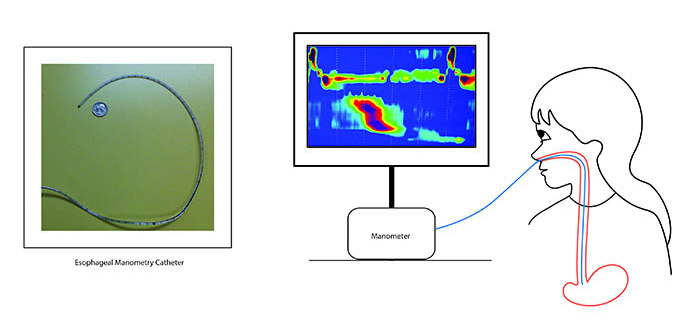Esophageal Manometry
Esophageal Manometry
Esophageal manometry is a diagnostic procedure used to assess the function and movement of the muscles and sphincters in the esophagus. The esophagus is the muscular tube that carries food and liquids from the mouth to the stomach. Esophageal manometry helps healthcare providers understand how the esophagus and its associated muscles are working, particularly in cases of swallowing difficulties, chest pain, gastroesophageal reflux disease (GERD), and other esophageal disorders.

During esophageal manometry:
- Preparation: Typically, patients are asked to fast for a few hours before the procedure to ensure that the stomach is not full. Medications that can affect muscle function may need to be temporarily stopped.
- Procedure: A thin, flexible tube called a manometry catheter is inserted through the nose and into the esophagus. The catheter contains sensors that can measure the pressure exerted by the esophageal muscles and the coordination of muscle contractions.
- Sensors: The catheter is positioned in specific locations along the esophagus to measure pressure changes as the patient swallows. These measurements help to assess the function of the esophagus and the lower esophageal sphincter (LES), a muscular ring that separates the esophagus from the stomach.
- Swallowing: The patient is given small sips of water to swallow, which allows the sensors to record the movement and pressure changes during the swallowing process. This information helps to evaluate how well the muscles and sphincters are functioning.
- Data Collection: The pressure data collected by the catheter is transmitted to a computer, where it is analyzed and interpreted by a healthcare provider.
Esophageal manometry provides valuable information about various aspects of esophageal function, including:
- Swallowing Function: It helps to evaluate the strength and coordination of muscle contractions during swallowing.
- Esophageal Motility Disorders: The test can identify motility disorders such as achalasia (a condition where the LES does not relax properly) and esophageal spasms.
- Gastroesophageal Reflux: It can assess the function of the LES and its role in preventing the backflow of stomach contents into the esophagus.
- Treatment Planning: The results of esophageal manometry guide healthcare providers in diagnosing and planning appropriate treatment for esophageal disorders.
Esophageal manometry is generally safe, although patients may experience temporary discomfort or mild irritation due to the presence of the catheter. The procedure is usually performed by a gastroenterologist or other healthcare professional trained in esophageal function testing.

